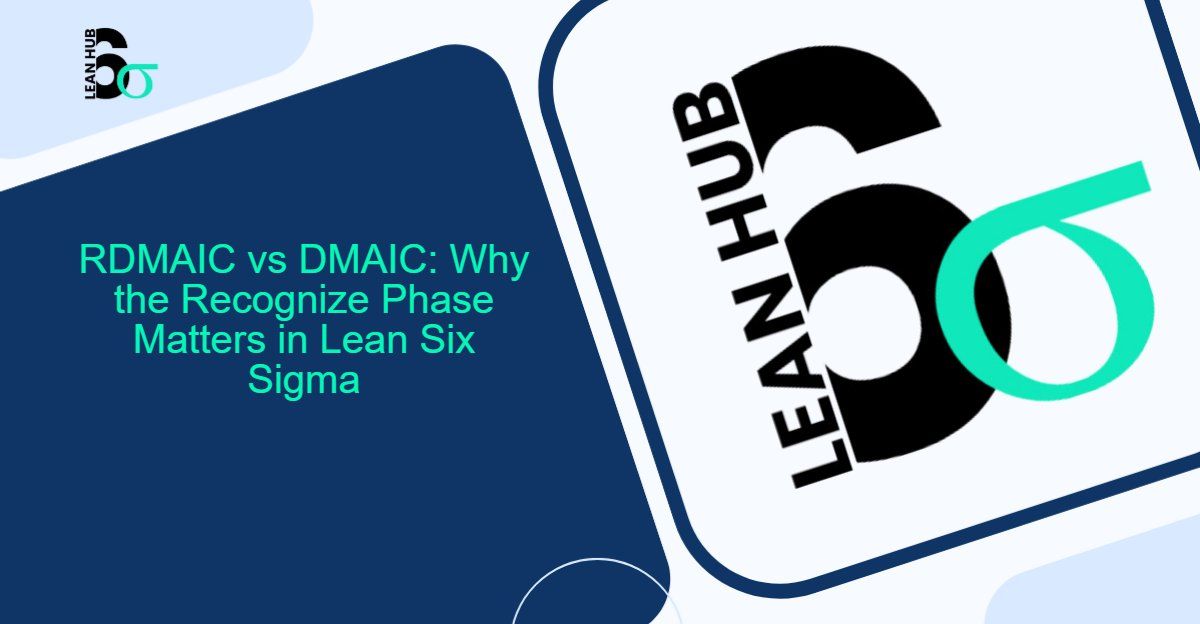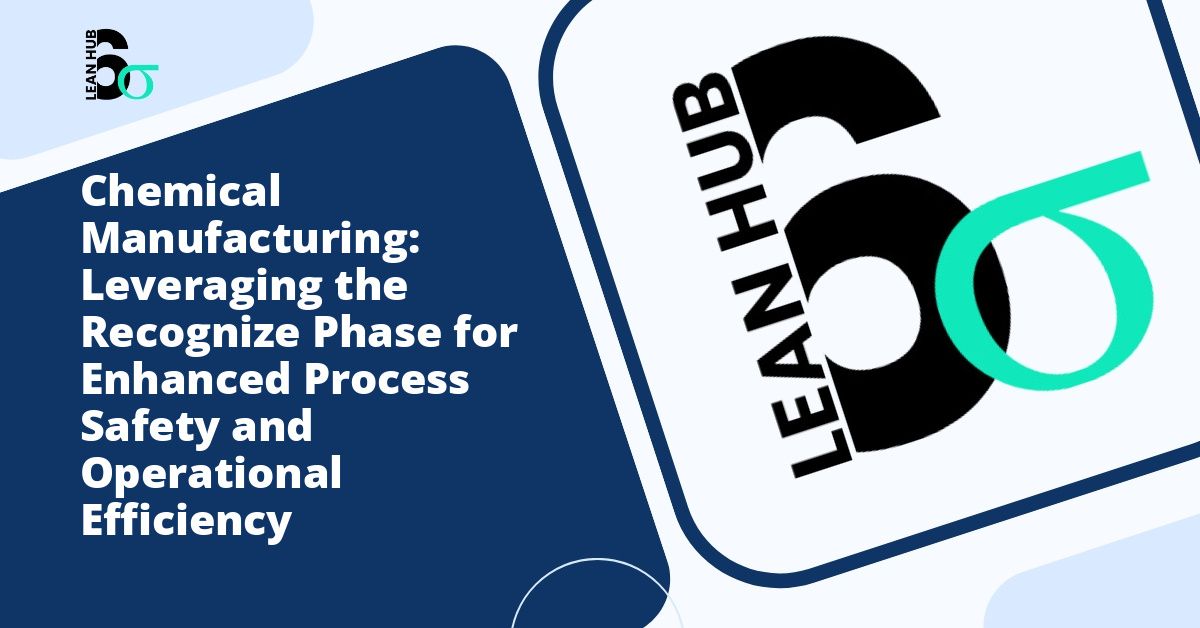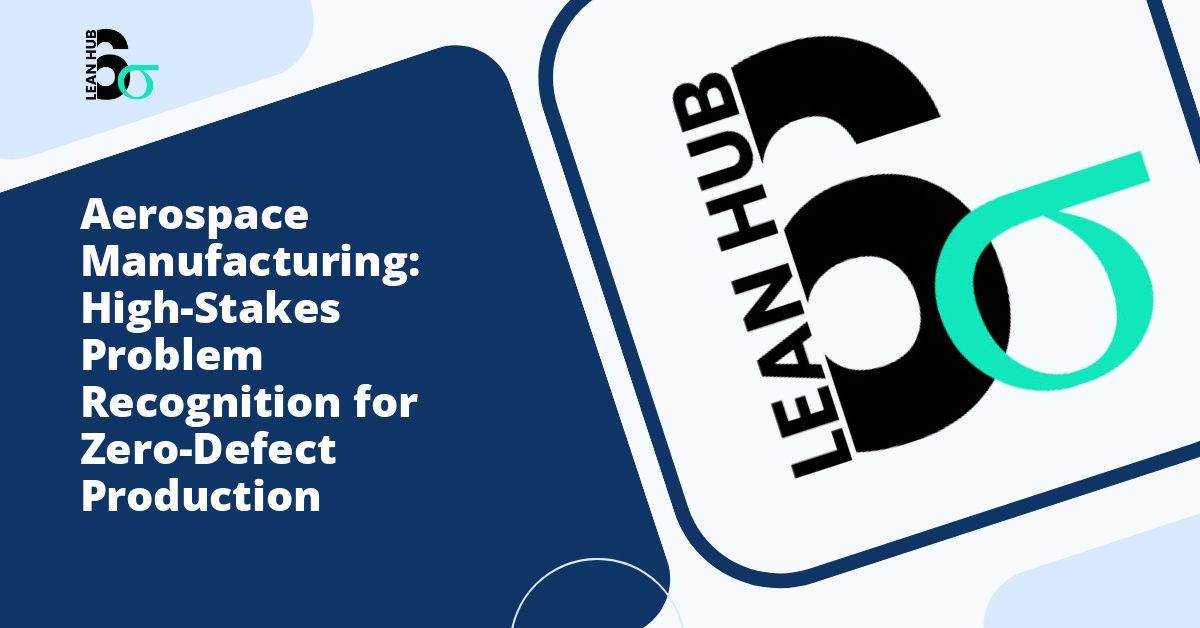Introduction
If you’re familiar with Lean Six Sigma methodologies, you’ve undoubtedly encountered DMAIC—the five-phase framework that stands for Define, Measure, Analyze, Improve, and Control. It’s been the backbone of process improvement initiatives for decades, helping organizations eliminate defects, reduce variation, and deliver exceptional results. But what if I told you there’s an enhanced version that’s gaining traction among forward-thinking organizations?
Enter RDMAIC—the DMAIC framework with a crucial addition: the Recognize phase in Lean Six Sigma. This preliminary phase addresses a fundamental challenge that many improvement projects face: starting with the wrong problem or failing to identify improvement opportunities altogether. In this comprehensive guide, we’ll explore what RDMAIC is, why that initial “R” makes all the difference, and what happens when organizations skip this critical step.
What is RDMAIC?
RDMAIC is an evolution of the traditional DMAIC methodology that adds a vital preliminary phase: Recognize. Let’s break down the complete framework:
- Recognize: Identify opportunities for improvement and determine whether a Six Sigma project is warranted
- Define: Clearly articulate the problem, project goals, and customer requirements
- Measure: Collect data to establish baseline performance metrics
- Analyze: Identify root causes of problems and validate them with data
- Improve: Develop and implement solutions to address root causes
- Control: Sustain improvements through monitoring and standardization
Understanding the Recognize Phase in Lean Six Sigma
The Recognize phase is where teams take a strategic step back to scan the organizational landscape for improvement opportunities. This phase involves:
- Reviewing organizational goals and strategic priorities
- Analyzing customer feedback and complaint data
- Examining process performance metrics and KPIs
- Conducting Voice of the Customer (VOC) exercises
- Evaluating potential project impact and feasibility
- Prioritizing opportunities based on strategic alignment and potential ROI
Think of the Recognize phase as your project filter and opportunity detector rolled into one. It ensures that before you invest significant time and resources into a DMAIC project, you’re confident that you’ve identified a genuine opportunity worth pursuing.
How RDMAIC Differs from Traditional DMAIC
While DMAIC assumes you’ve already identified a problem worth solving, RDMAIC acknowledges that problem identification itself is a critical capability that deserves structured attention. The traditional DMAIC approach often relies on management intuition or reactive fire-fighting to select projects. RDMAIC, by contrast, creates a systematic approach to opportunity recognition that’s data-driven and strategically aligned.
Why the Recognize Phase Matters
The addition of the Recognize phase in Lean Six Sigma isn’t just procedural overhead—it addresses real challenges that plague improvement initiatives. Here’s why this phase is game-changing:
1. Strategic Alignment from Day One
The Recognize phase ensures that improvement projects directly support organizational strategy. Rather than working on problems that seem urgent but lack strategic importance, teams can prioritize opportunities that move the needle on business-critical metrics. This alignment increases executive buy-in and ensures resources are directed toward initiatives that matter most.
2. Enhanced Resource Utilization
Six Sigma projects require significant investment—trained personnel, time, data collection resources, and management attention. The Recognize phase helps organizations avoid the costly mistake of launching projects that fizzle out or deliver minimal impact. By vetting opportunities upfront, you ensure that your Black Belts, Green Belts, and project teams are working on initiatives with genuine improvement potential.
3. Reduced Project Failure Rate
Studies suggest that a significant percentage of Six Sigma projects fail to deliver expected results. Many failures trace back to poorly defined opportunities or projects that shouldn’t have been initiated in the first place. The Recognize phase acts as a quality gate, significantly reducing the risk of project failure by ensuring sound problem selection.
4. Proactive vs. Reactive Improvement Culture
Organizations without a structured Recognize phase often operate reactively, addressing problems only after they’ve become crises. RDMAIC fosters a proactive culture where teams continuously scan for improvement opportunities before they escalate into major issues. This shift from reactive to proactive dramatically improves organizational resilience.
5. Better Stakeholder Engagement
When you can demonstrate that a project was selected through rigorous analysis of customer needs, business impact, and strategic alignment, stakeholder buy-in comes more naturally. The Recognize phase provides the documentation and rationale that helps you build a compelling case for your improvement initiative.
Examples of What Happens Without the Recognize Phase
To truly appreciate the value of RDMAIC, let’s examine real-world scenarios where the absence of a structured Recognize phase led to problematic outcomes:
The Manufacturing Company That Solved the Wrong Problem
A mid-sized manufacturing company launched a Six Sigma project to reduce defects in their flagship product line. The team spent four months measuring, analyzing, and implementing improvements, ultimately reducing defects by 40%. Success, right?
Not quite. What they failed to recognize upfront was that customer complaints weren’t primarily about product defects—they were about delivery delays. The company had invested significant resources solving a problem that, while real, wasn’t their most critical issue. A proper Recognize phase would have identified delivery performance as the priority opportunity through customer feedback analysis.
The result: Four months of effort with minimal impact on customer satisfaction or revenue. The team later had to launch a separate project addressing delivery issues—the problem they should have tackled first.
The Healthcare Provider’s Scope Creep Disaster
A regional healthcare provider initiated a DMAIC project to improve patient wait times in their emergency department. Without a Recognize phase to properly scope the opportunity, the team started with an overly broad problem statement that encompassed everything from triage to discharge.
Three months into the project, the team was overwhelmed with data, unable to identify clear root causes, and facing resistance from multiple departments. The project eventually stalled, having consumed countless hours of clinical and administrative time without delivering improvements.
The result: Team burnout, wasted resources, and skepticism about future improvement initiatives. A Recognize phase would have helped narrow the scope to a manageable, high-impact segment of the patient journey.
The Financial Services Firm That Ignored Strategic Priorities
A financial services company empowered department managers to launch Six Sigma projects addressing their pain points. Without enterprise-level recognition and prioritization, different departments initiated 15 simultaneous DMAIC projects.
The company’s limited pool of trained Black Belts was stretched impossibly thin. Many projects received inadequate support and failed to reach the Improve phase. Meanwhile, a critical compliance issue that threatened regulatory penalties went unaddressed because no one had recognized it as an improvement opportunity requiring Six Sigma rigor.
The result: Diluted resources, multiple incomplete projects, and a missed opportunity to address a strategically critical issue. A centralized Recognize phase would have prioritized the compliance issue and limited concurrent projects to what the organization could realistically support.
The Technology Company That Chased Symptoms
A software company noticed an uptick in customer support tickets and immediately launched a DMAIC project to improve their support team’s response time. The team succeeded in reducing average response time by 35%.
However, support ticket volume continued to increase. The real opportunity—which a Recognize phase would have uncovered—was that a recent software update had introduced usability issues. Rather than improving support response, they needed to fix the underlying product problems causing the support requests.
The result: A more efficient support team handling an unnecessary volume of tickets, while the product issue continued to frustrate customers and damage the brand.
Implementing the Recognize Phase in Your Organization
Ready to embrace RDMAIC? Here are practical steps to implement an effective Recognize phase:
Create a Structured Opportunity Pipeline
Develop a system for continuously capturing potential improvement opportunities from multiple sources: customer feedback, employee suggestions, process metrics, competitive intelligence, and strategic goals. This pipeline becomes your source material for the Recognize phase.
Establish Clear Evaluation Criteria
Define the criteria you’ll use to evaluate potential projects, such as strategic alignment, estimated ROI, resource requirements, project complexity, and customer impact. Create a scoring rubric that enables consistent, objective evaluation.
Conduct Regular Recognition Sessions
Schedule quarterly or monthly sessions where cross-functional teams review the opportunity pipeline, evaluate potential projects using your established criteria, and prioritize initiatives for DMAIC execution.
Document Your Recognition Process
Create a simple template that captures why a project was selected, including the business case, expected benefits, strategic alignment, and preliminary scope. This documentation proves invaluable during the Define phase and for securing stakeholder support.
Conclusion
The Recognize phase in Lean Six Sigma isn’t just an add-on—it’s a fundamental enhancement that addresses one of the most critical challenges in process improvement: making sure you’re working on the right problems. By adopting RDMAIC instead of traditional DMAIC, you’re positioning your organization for more successful projects, better resource utilization, and stronger strategic alignment.
Whether you’re a seasoned Six Sigma professional or just beginning your continuous improvement journey, incorporating a structured Recognize phase can dramatically improve your project success rate and organizational impact. The examples we’ve explored demonstrate that skipping this phase isn’t a time-saver—it’s a recipe for wasted effort and missed opportunities.
The next time you’re tempted to jump straight into defining a problem, pause. Take the time to properly recognize the opportunity landscape. Your future self (and your organization) will thank you.








